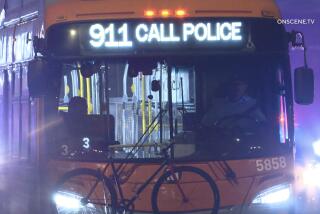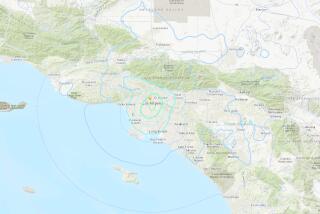Rescuers Work Among Carnage
- Share via
Ruben Landa was working next to the tracks outside the Costco warehouse when the steel uprights and walls of the building shuddered from the force of train cars slamming into earth.
Landa hopped a chain-link fence and ran toward the wreck.
“It was dark. I saw people crying, people screaming in pain, but not at the top of their lungs,” he said. He climbed into a rail car that had split open and found a man trapped beneath a seat.
“I grabbed him underneath his shoulders,” Landa said. “He said he couldn’t breathe.”
Not far away, an eerie feeling passed through Glendale Fire Capt. Greg Godfrey as he rushed toward the shattered Metrolink train. It was, he realized, the same train he used to ride to work from his home in the San Fernando Valley.
But in the dim light of dawn, as survivors crawled from windows and limped bleeding down the railroad tracks, Godfrey said, he could barely recognize the mess as a train.
“It was just total disarray, with twisted metal everywhere, and seats that were so mangled you couldn’t even tell they were seats anymore,” he said.
Meanwhile, at the Los Angeles Police Department’s Northeast Division, three short beeps came over the radio at 6:03 a.m. The announcement, “train derailment,” prompted officers to run for their cars.
For the scores of bystanders, firefighters and police officers who rushed to the scene of Wednesday’s Metrolink derailment, the experience proved to be one of the most difficult and gruesome of their lives.
At the nearby Costco warehouse, employees rushed to the scene with fire extinguishers.
Mark Zavali, a 20-year Costco employee, had been unloading goods since 4 a.m. when he heard the crash.
Outside, it was still dark, but flames coming from one of the derailed train cars cast a faint glow.
“Diesel fuel was pouring out onto the ground. We got it all over our clothes. We were scared it was going to catch on fire,” said Zavali, 39. “We saw scores and scores of people coming out of the train. Some of them didn’t even have a scratch on them.”
Juan Guzman watched as his co-workers pulled a badly injured man from the wreckage.
“They couldn’t even hold his hand,” said Guzman, who said the man appeared to be in his 60s. “There was blood everywhere. His bones were all busted up. His legs were like spaghetti, and one of his arms was bent all the way back.”
Zavali helped carry the man to the parking lot.
“He told us: ‘Don’t let me die. Pray for me,’ ” Zavali said.
Later, firefighters told them the man had not survived.
Godfrey and his three-man crew from Station 26 had just returned from a false alarm when they were called to the derailment. The scene was worse than anything they ever imagined.
Passengers crawled from the wreckage with compound fractures and other serious injuries. Fuel was leaking and some cars were burning. From within, they could hear cries for help.
As a former train rider, Godfrey knew his way around the interiors of the double-decker cars -- where to find the steps, the restrooms, and where people were most likely to be sitting at 6 a.m.
The crew entered one car and found a man with an open leg fracture on the lower level. Godfrey told him to sit tight and wait for more help as he moved to the top in search of more gravely injured victims.
The scene was even grimmer above. Two dead bodies were entangled in the debris. Another passenger, a man in his late 40s or early 50s, was alive, but he too seemed impossibly stuck in the tangle of metal. His lower body was pinned, and he was pleading for help.
In moments, a Los Angeles Fire Department crew arrived and began using the “jaws of life,” a hydraulic device to pry apart the wreckage. It was slow going, but Los Angeles firefighter Travis Warford said they finally managed to free the man. “It was just a lot of twisted metal,” Warford said.
Ted Williams, an LAPD officer, jumped into a train car that was perched at a precarious 45-degree angle. As he searched for injured passengers, the car felt as if it would fall at any moment.
“The train is teeter-tottering and you’re trying to walk,” Williams said. “It makes you a little nauseous.”
He pulled at least four victims from various cars. He most remembered a man whose legs were splayed at odd angles due to fractures and tangled with the body of a dead Los Angeles County sheriff’s deputy. Williams said he was reluctant to leave the pair, but the injured person urged him to help others.
Williams was struck by the man’s selflessness.
“I don’t know who this guy was, but he’s just awesome,” Williams said. “Who else do you know would do something like that? Whatever life he had in him, he was willing to sacrifice. He was willing to sacrifice whatever to be with this guy.”
Another LAPD officer, Susan Solley, held one man’s hand as he died.
“I just squeezed his hand and that was it. They came to take his pulse, and he was gone. You want to believe that you can help everyone, but you can’t.”
*
Times staff writers Greg Krikorian and Monte Morin contributed to this report.
More to Read
Sign up for Essential California
The most important California stories and recommendations in your inbox every morning.
You may occasionally receive promotional content from the Los Angeles Times.










